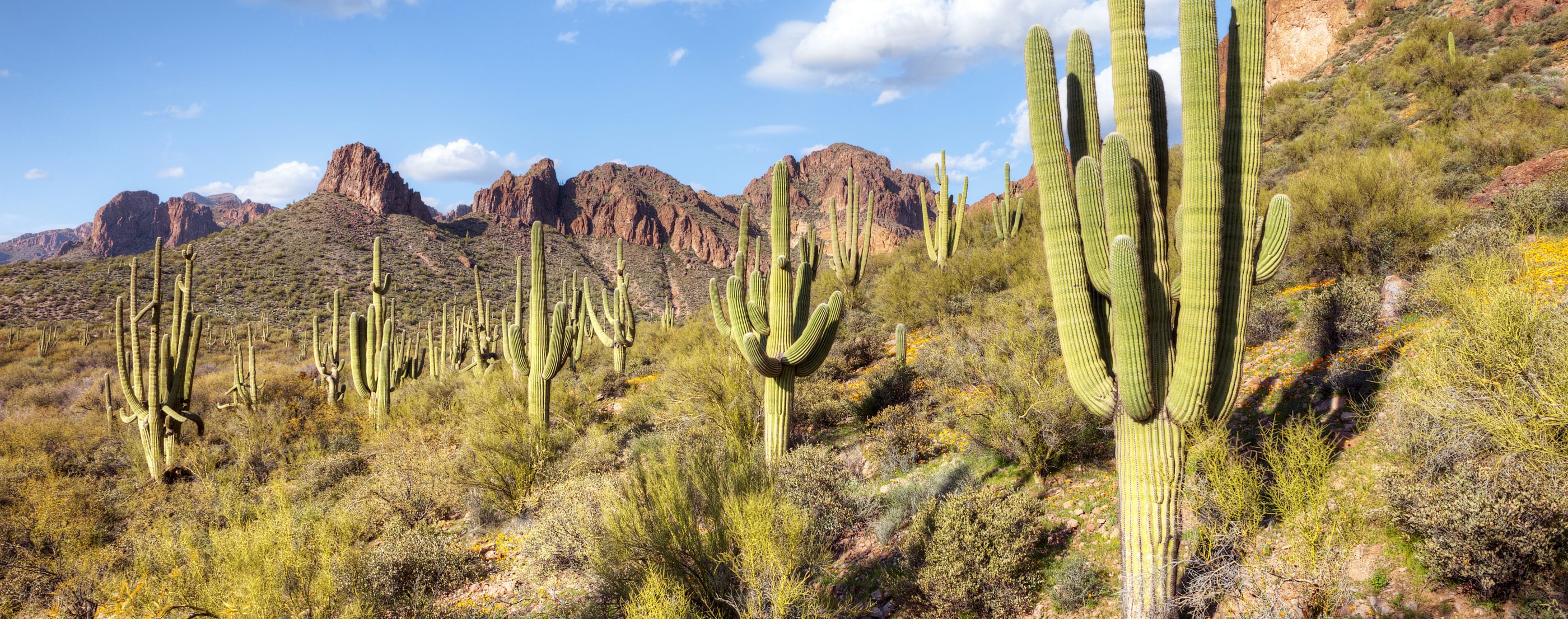Arizona, with all of its desert, sand and sun, epitomizes astonishing contrasts—and the personality of Phoenix is no exception. The state’s capital is nestled in the Valley of the Sun near the junction of the Salt and Gila Rivers, in the northernmost reach of the Sonoran Desert. Craggy ranges and a whimsical saguaro forest rise up around the city, creating an exceptional playground for recreationists.
And that matchless terrain juxtaposes with one of the largest metropolitan hubs in the country: the Greater Phoenix area, home to a population of 4.5 million including the adjacent cities of Tempe, Scottsdale and Glendale. Visitors can ride horseback between the palo verdes and prickly pears or mountain bike past tall chollas and ocotillos, then un-dust in the energetic urban grid before catching tee time, a new art exhibit or live jazz. This is a place that doesn’t sacrifice ruggedness or refinement—you can have both.
If you’re just starting to explore the idea of traveling to Phoenix, this guide will cover:
- Why Visit the Desert Southwest via Phoenix?
- The Best Places to Visit in and Near Phoenix
- The Top Outdoor Activities Around Phoenix
- How to Plan Your Trip
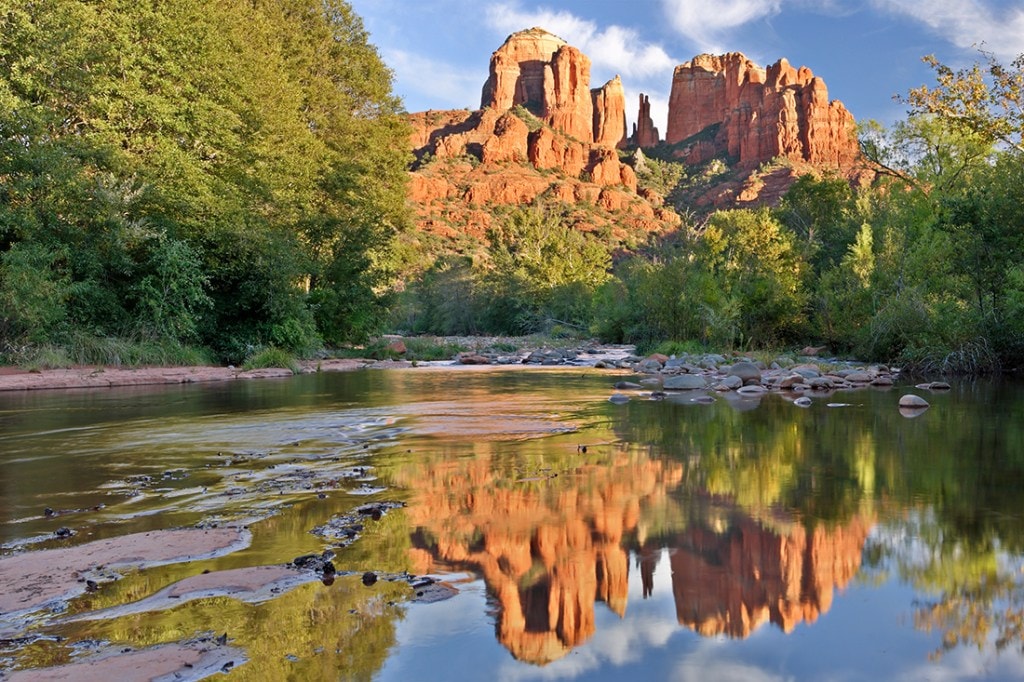
The Cathedral Rocks and their reflection refract in Oak Creek near Sedona, Arizona.
Why Visit Phoenix?
An extraordinary landscape fills the Phoenix skyline: rugged, sun-scoured mountains and sweeping lowlands with a speckled pattern of sky-reaching saguaro cactus. The peculiar saguaro, pronounced sah-WAH-roh, grows only in the Sonoran Desert, including parts of Arizona, California and Mexico.
These nationally protected cacti feature vertical corduroy and thick arms that swoop up like candlestick holders, which create silhouettes against the dry landscape. Incredibly slow-growing, these desert old-timers live for 200 years, reach up to 50 feet high and cradle the state flower each spring. From May to June, a tiara of white, waxy blooms appears atop the cactus before it’s pollinated and matures into a bright, crimson-colored fruit.
Beyond the iconic saguaro, the Sonoran Desert supports an array of interesting cacti and wildlife from kangaroo rats and desert tortoises to rattlesnakes. The majority of Arizona’s land is preserved, meaning the special ecology, natural beauty and human history around Phoenix can thrive for generations to come. By the numbers: 28 percent of the land belongs to Indigenous tribes, 13 percent is state-owned, and close to 40 percent is managed by federal agencies.
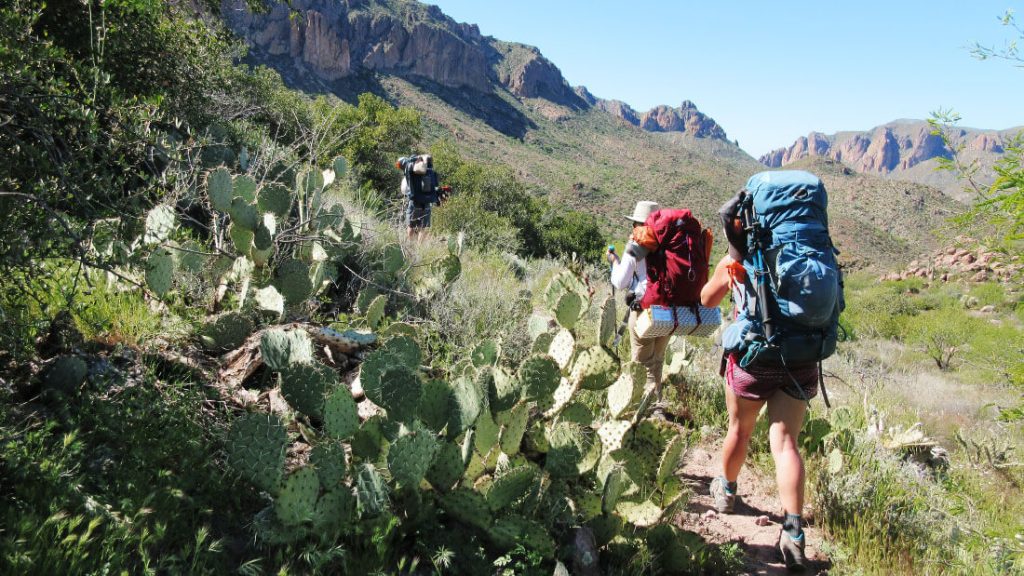
Backpackers hike through the Superstition Mountains.
East of the city, the Superstition Mountains form a stunning backdrop of jagged volcanic peaks. The Mazatzal Mountains—adjacent to the Superstitions and north of the metro area—reach 7,903 feet in elevation: one of the highest-reaching landmarks near Phoenix. But, surprising to most visitors, more than half of the state sits at an elevation of 4,000 feet (or more) above sea level. As a result, Coconino National Forest, 100 miles due north of the city, holds the largest family of ponderosa pine trees in the world.
With perpetual sunshine and a plethora of public lands, it’s easy to see why Phoenix is attracting a growing stream of travelers each year. And that buzzing growth has catalyzed a renaissance inside city limits. Phoenix is experiencing an urban renewal with flourishing breweries, street art, public transportation and culinary talent. Newcomers can step into this bustling oasis, garnished with a warm breeze and swaying palms, and indulge in top-notch accommodations, shopping, restaurants, breweries and entertainment opportunities. But first, there is plenty of outdoor adventure on tap.
The Best Places to Visit in and Near Phoenix
Camelback Mountain
Camelback Mountain is perhaps the most famous landmark in the city. The sandstone and granite ridge resembles a resting camel and invites hikers from all over the world to climb its flanks. To reach the camel’s hump, hikers ascend a 2,700-foot face on steep, uneven ground (look for trail markers) that’s bordered by jumping cholla and pincushion cacti.
The heart-racing climb is worth the 360-degree views, but be sure to carry plenty of water. Camelback is only a 20-minute drive from downtown, so in the cooler months of winter and spring the parking lot can fill up. If the entry gate is closed, circle back in 20 minutes.
McDowell Mountain Regional Park
Northeast of Phoenix, the protected area of McDowell Mountain Regional Park (one hour outside of Phoenix by car) provides more than 50 miles of trails for mountain bikers, horseback riders, hikers and trail runners. You can pick an easy, short hike about 3 miles long, or spend a greater chunk of the day outside on 15.3-mile Pemberton Trail.
Regardless of the trail you choose, you can’t go wrong with the views: Scottsdale’s skyline is to the west, ridgelines in Tonto National Forest are to the east and the Superstition Mountains are to the southeast.
Roosevelt Row Arts District
Roosevelt Row Arts District (RoRo) is a charming historic-cultural neighborhood in downtown Phoenix. Each block is decorated with vibrant street art that’s been created by popular artists in the community. Take a self-led walking tour to explore the murals, award-winning galleries, rotating exhibits, boutiques, restaurants and jazz clubs.
Tempe Town Lake
Only 11 miles east of Phoenix is Tempe Town Lake: a 2-mile long body of water in the middle of the city grid, which was created by damming a portion of the Salt River. Folks can kayak, stand up paddle board, pedal boat, pontoon boat, fish or join a rowing class—all with the two Mill Avenue Bridges as a backdrop.
Mesa Grande Cultural Park
Hohokam translates as, those who are gone. The Hohokam people lived in central Arizona 2,000 years ago, and their prehistoric civilization developed the most sophisticated irrigation system in the Southwest: 500 miles of canals irrigated 110,000 acres, which supported crops for up to 80,000 people.
This ancient culture is most known for their phenomenally engineered canals, but the Hohokam also built large earthen platform mounds in the center of their villages, which may have been used for ceremonies or to house upper class society.
Mesa Grande Cultural Park encircles Mesa Grande Ruins, one of only two remaining Hohokam temple mounds in metro Phoenix (the other is the Pueblo Grande Museum). Listed on the National Register of Historic Places, the archaeological site encompasses ball courts and a platform mound that is longer and wider than a football field and 27 feet high.
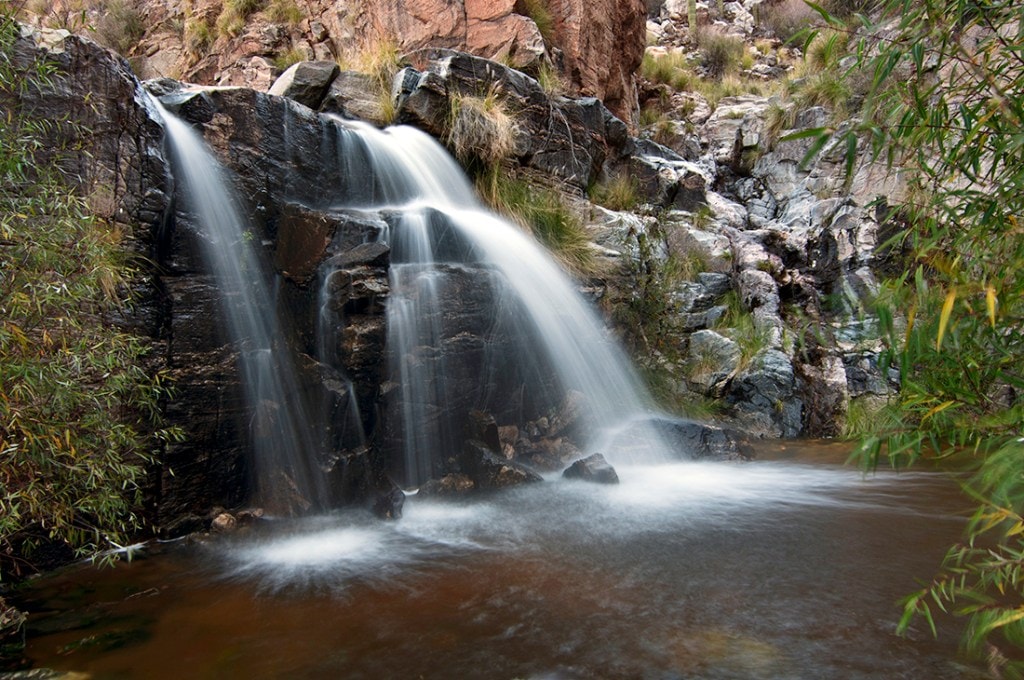
One of the main waterfalls at Seven Falls in the Catalina Mountains north of Tucson, Arizona.
McDowell Sonoran Preserve
Outdoor lovers flock to this 30,000-acre preserve to recharge. And for good reason: the McDowell Sonoran Preserve gives visitors and locals more than 200 miles of rolling trails to escape the city whirlwind. In fact, this area is one of the largest urban preserves in the country.
Hikers, mountain bikers, runners, horseback riders and rock climbers can choose from a variety of routes among the lush yucca and agave plants of the McDowell Mountains. Check out the moderate 4-mile loop around Gateway Saddle—with expansive views and 600 feet of elevation gain—on the west side of the preserve.
Lake Pleasant
Forty miles north of Phoenix is Lake Pleasant, a bright gem in the middle of the Sonoran Desert. Surrounded by saguaros, the lake flaunts 10,000 acres and is the second largest body of water in Arizona. You can grab water gear at two marinas—Pleasant Harbor and Scorpion Bay—including jet skis, canoes, kayaks, speedboats, sail boats, stand up paddle boards and fishing boats.
Anglers can hook white bass and stripers in the deeper water. But tossing a line at night increases the odds of a catch: Fish, including catfish and largemouth bass, escape the day’s heat by swimming farther below the surface.
Desert Botanical Garden
This thriving museum and world-class garden curates more than 50,000 desert plants across its 140-acre property. At time of writing, 55 acres are being actively cultivated including the care of 379 rare and endangered species. Hop on a trail, stroll through the Sonoran flora, or join one of the daily guided tours. Look for nighttime light shows, concerts and other special events.
South Mountain Park and Preserve
Besides the blossoms and ancient petroglyphs, South Mountain Park has a 50-mile trail network for horseback riding, mountain biking and hiking. With more than 16,000 acres to explore, South Mountain Park is 20 times larger than Central Park in New York City and is one of the largest municipal parks in the U.S. The trails offer a mix of sharp inclines and flat rollers. Dobbins Lookout, the highest accessible point in the park at 2,330 feet in elevation, poses a wide panorama of the city. A paved road to the viewpoint enables anyone to experience the observation deck.
Sonoran Preserve
In northern Phoenix, the Sonoran Preserve maintains more than 18,000 acres of prosperous desert and spotlights 36 miles of multi-use trail including horse, bike and foot traffic. The three trailheads include Desert Vista, Apache Wash and Desert Hills.
Stretched between the latter two is Sidewinder Trail: the longest, most difficult choice in the northernmost crescent of the preserve. Sidewinder leads hikers to Apache Vista and Ridgeback Overlook, two viewpoints that are among the city’s Seven Summit Challenge. The official checklist also comprises Deem Hills, Lookout Mountain, Shaw Butte, Dobbins Lookout on South Mountain and Piestewa Peak.
Aravaipa Canyon Wilderness
Aravaipa Canyon Wilderness embodies the wild with thick vegetation and sky-reaching cliffs. There are few designated trails, so travelers need to venture into the canyon with Leave No Trace principles and navigation skills. Hikers can follow Aravaipa Creek on an 11-mile (one-way) out-and-back. The trail pokes through the creek and both banks: wear protective footwear that’s suitable for hiking and water.
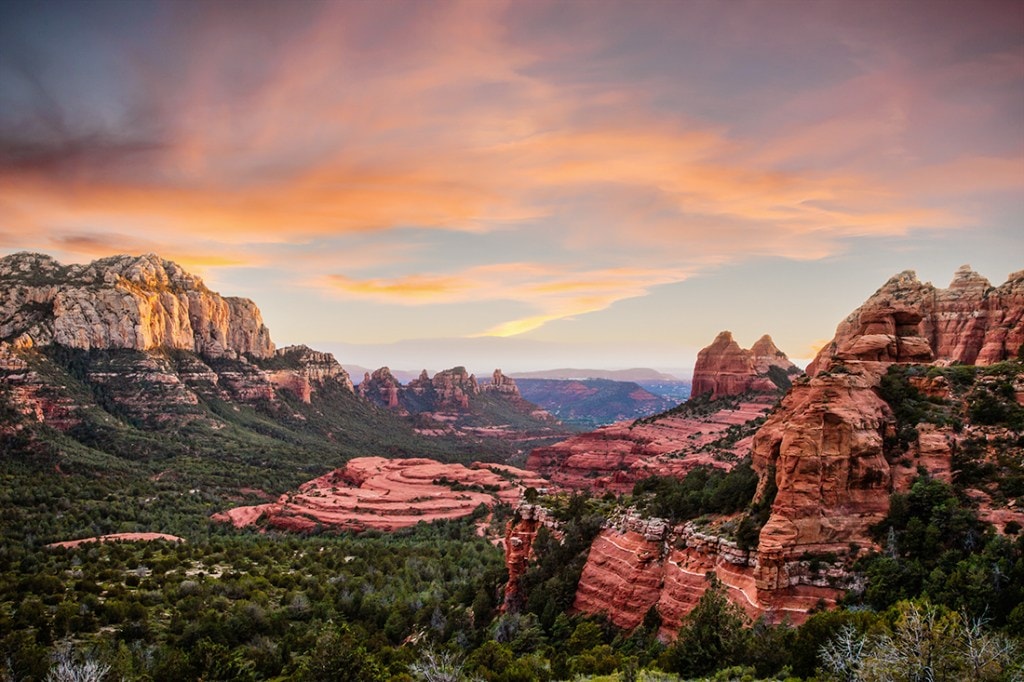
A red rock sunset near Sedona, Arizona, ripples across the skyline.
Red Rock State Park
This state park is near Sedona and spotlighted for its geological gems. Oak Creek flows through the landscape, which supports a unique intersection of habitats and wildlife including the javelina and Sonoran mud turtle. Peruse the Hiline Trail, a 3-mile (one-way) out-and-back journey with a steep, technical ascent. At the top of the mesa, soak up the surrounding views of castle-like red rock formations.
Superstition Wilderness
East of Phoenix is the stark and stunning Superstition Wilderness. The area expands across 160,000 acres and holds an extensive system of trails, which provide a portal to experience this solitary landscape. All together, the trail system includes 170 miles of singletrack in the wilderness and its contiguous areas. A handful of trails link together the wilderness area with Lost Dutchman State Park. Take a stroll on Black Mesa Trail (241): the 3-mile (one-way) trail is lined with significant groves of cholla cactus.
REI offers a variety of rental equipment around the Phoenix area as well.
The Top Outdoor Activities in Phoenix
1. Hiking and Trail Running
Established trail networks line the mountains and open spaces of Phoenix, providing easy outdoor access to runners and hikers, plus bird’s-eye views of the city. Aravaipa Running—a local company that organizes trail and ultrarunning events across the Southwest—was founded here in Phoenix, a decade ago.
If you enjoy spectating or want to jump into the mix, Aravaipa stages desert races nearly every month of the year. In and around Phoenix, the singletrack is well-marked and mostly rolling, with a variety of distances for all experience levels and schedules. Before you head out, consider hitting the dirt during the coolest times of day—the early morning and evening—especially if you’re heat-sensitive or traveling in the mid-summer.
2. Mountain Biking
Moab is synonymous with slickrock. Colorado’s horizons boast snowcapped fourteeners. But lesser-known is that one hour north of Phoenix, mountain bikers can roll into one of the most outstanding backyard-to-backcountry trips in the country. Arizona’s Black Canyon Trail is among the top 20 best mountain bike trails in the U.S., according to the Bureau of Land Management and the International Mountain Bicycling Association (IMBA). The 80-mile journey is rough, rocky and follows a trade route formerly used by Indigenous tribes and traders.
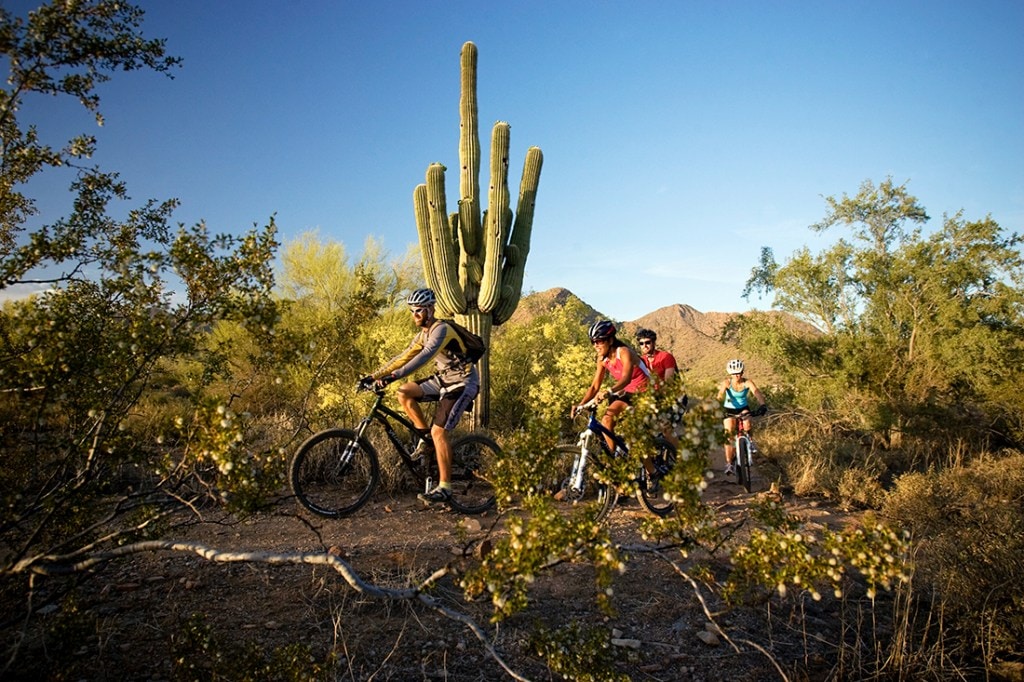
Mountain bikers enjoy the Sonoran Desert singletrack.
There’s more: Don’t miss Cave Creek Cactus Classic Loop, a 24-mile ride that’s 45 minutes north of downtown. Cross-country riders can locate smoother singletrack in the Hawes Trail Network. And National Trail, a 14-mile out-and-back on South Mountain, gives experienced riders a technical challenge in one of the largest urban parks in the nation, which is located south of downtown.
3. Paddling
Rafters, kayakers, stand up paddle boarders: It might be hard to believe, but Phoenix has plenty of water to balance out the desert action. Six lakes are within a 75-minute drive of the city, and most paddle areas are accessible year-round. Bartlett Lake and Saguaro Lake—both reservoirs—are mellow and wave-free. Other spots like Lake Pleasant and Canyon Lake host camping. Tempe Town Lake offers gear rentals. And for those craving whitewater, the Salt River, which flows westbound from the White Mountains into Phoenix, has an upper stretch that’s chock-full of Class II-IV rapids.
4. Rock Climbing
The Phoenix area hosts hundreds of sport routes, traditional routes and boulders for climbers of all experience levels. More than 200 climbs decorate the granite faces of the McDowell Mountains and Pinnacle Peak. Then, closer to the metro area, climbers can check off another 200 options at Camelback Mountain and South Mountain, a mecca for bouldering. Trad climbers will find their biggest project list in the Superstition Mountains, east of the city.
5. Horseback Riding
Horseback riding has a proud place in Southwestern history, and just outside of Phoenix, wild mustangs still roam near the lower Salt River. If you’ve never ridden a horse, the Phoenix area is a quintessential place to step into stirrups. Travelers can interact with and ride these majestic animals at local dude ranches or on a horseback tour, which are usually offered as full-day or half-day rides.
How to Plan Your Trip
Best times to visit
Phoenix is spoiled with a sublime amount of sunshine. In a given year, sunlight reaches the surface for 85 percent of all daylight hours, making it the third sunniest location in the U.S., reports the National Oceanic and Atmospheric Administration. And the humidity is low year-round—so, be sure to pack your water bottle and hydrate more than usual.
On average, winter months deliver blue skies, highs in the 60s and 70s, and lows that hover in the 40s. Winter nights can be chilly, but it’s rare for Phoenix temps to dip below freezing. Springtime sits in the 80s and 90s with cool evenings. Spring also delivers a show of blooming cacti and wildflowers.

Arizona gets hot—, especially in the summer! Finding shade and water can help mitigate the heat.
The summer heat touches the triple digits—July’s average is 106 degrees—but the hotness factor can also be a reprieve on the pocketbook as many hotels lower their prices by as much as 30 percent. If you do a summer trip, add daily siestas to your itinerary and pack flip-flops for the waterside, because ground heat is hard on the feet.
In autumn, Phoenix is the perfect corner to extend your summer: While the conditions of many U.S. locations plummet into the season of long-sleeves and scarves, the temperatures here drop into and hover in the 80s and 90s.
Where to Stay
Dude ranches, lakeside campsites, hostels, luxury villas, water parks with lazy rivers: Phoenix has any style of accommodation that you envision. And it’s easy to find an abode when you need it, because the Greater Phoenix area bears more than 450 hotels and 40 resorts.
The Camby
This contemporary hotel showcases a funky, western flare. Cattle, copper, citrus, climate and cotton breathe life into the decor. If you’re in need of a luxurious pad with a rooftop pool and Southwest-inspired cuisine, this is a great option.
FOUND:RE
Conveniently located in downtown Phoenix, this avant-garde art boutique hotel shows off the creations of local artists. The atmosphere is a blend of industrial design with simple comforts like plush mattresses and thick towels. Match, the in-house restaurant, rotates the menu’s ingredients based off of the seasons.
Phoenix Hostel
This is Arizona’s sole hostel and cultural center, and the organization’s mission is to provide an affordable haven for travelers of all ages. The spectrum of overnight options includes private, family or dorm-style rooms. And the art center contains a curation of work from artists from around the globe.
Where to Eat and Drink
Phoenix Public Market Cafe
Pull up a seat and meet new friends at one of the long, wooden tables in the Phoenix Public Market Cafe. The communal vibe and seating is paired with farm-to-table food that’s made with fresh, local ingredients. From pies to macaroons, guests can splurge on the impeccably crafted baked goods.
The market is led by Chef Aaron Chamberlin, one of the Valley’s top restaurateurs. Chamberlin has received nods from the James Beard Foundation and was recognized as Chef of the Year by the Arizona Culinary Hall of Fame—so, you’re likely to swoon over something on the menu.
Two Brothers Tap House and Brewery
Founded by Jim and Jason Ebel, the brother-owned brand has evolved over two decades to include several brewpubs, coffee roasters and artisan beers. Their Scottsdale location operates a 10-barrel brewing system plus tasty food.
Snooze: an AM Eatery
Snooze puts a twist on the American classic breakfast and produces a playful, eclectic vibe. The menu is famous for novel pancakes—like the sweet potato buttermilk or the blueberry danish with lemon cream-cheese—and artful hollandaise dishes like the Smashed Avocado Benny with green chile and vine-ripened tomatoes.
Cartel Coffee Lab
When you need to work from the road, or you’re simply in need of a flavorful cup of coffee, check out Cartel. This local coffee shop roasts their beans in-house and brews a variety of craft beers, too. The original location is in Tempe, but you’ll find their newest spots in downtown Phoenix and Scottsdale.
The Beer Research Institute (BRI)
BRI opened in 2014 with a five-barrel brew house and a passion for well-crafted beers. Grab a flight to sample their array of flavor profiles, from the Belgian blonde to a sweet stout, sour ale or blueberry saison.
Blasted Barley Beer Co.
This locally owned brew house is in the heart of downtown Tempe, and it’s just as famous for its patio and burgers as it is for its beer. If you’re famished and open-minded, order the Peanut Butter & Jelly Burger and the Grandpa Pills: a pre-Prohibition pilsner recipe co-created by master brewer Cooper Sepulveda and his grandfather.
What to Pack
The warmth of the desert allures travelers, especially those who prefer sunshine over white and frigid conditions. But using sun-protective apparel and gear helps to prevent sun damage. Consider this well-rounded pack list as you prepare for Arizona:
- Water bottle or hydration system
- Sunglasses
- Sun hat
- Sun shirt
- Bathing suit
- Sunscreen
- Hiking shoes
- Hiking sandals
- Daypack
Getting From Place to Place
Phoenix and its sister metros offer public transit including bike share programs and a light rail system, which means exploring this urban landscape is easier than ever.
Bike share
Commuters use the bike share program, called Grid, to venture around Phoenix and the greater area of Mesa, Tempe and Scottsdale. Grid helps folks explore city neighborhoods via two wheels, pedal between destinations or use a bike to link-up with the Valley Metro.
Valley Metro
The Valley Metro Rail connects Tempe, downtown Phoenix and Phoenix Sky Harbor International Airport. At print, there are 35 light rail stations that dot the entire 26-mile rail route. If you need to use both the bus and light rail, the one-day pass is valid for both modes of transit (one ride is $2, and an all-day passes are $4.)
Roadtrippers: Don’t Miss These Stops
It’s on every person’s bucket list: Only 3.5 hours north of Phoenix is the Grand Canyon, one of the Seven Natural Wonders of the World. At the park, take a 3-mile stroll along the Grand Canyon South Rim for some of the top lookouts in the canyon.
Kartchner Caverns State Park
It’s easy to forget that exploration exists underground, but Arizona happens to have one of the most incredible explored cave systems on Earth. Kartchner Caverns State Park hides one of the world’s longest soda straw stalactites—it’s more than 21 feet long—as well as the most extensive formation of brushite moonmilk that’s known on the planet. Visitors can also scope out the largest column in Arizona: the 58-foot-tall Kubla Khan. Kartchner is only a 2.5-hour drive south of Phoenix.
Organ Pipe Cactus National Monument
Organ Pipe Cactus National Monument is on the list of the UNESCO World Network of Biosphere Reserves, and the monument is also the only place that organ-pipe cactus grows in the nation. The unique columnar arms of the cactus stretch upward and grow to be 16- to 26-feet high. This one-of-a-kind reserve is located two hours south of Phoenix, near the U.S.–Mexico border and is an excellent place for camping (there are even drive-up campsites with showers), hiking, mountain biking and bikepacking.

Organ Pipe Cactus National Monument is home to the columnar cacti that bears its name.
While visiting Organ Pipe Cactus National Monument, check out the Bull Pasture and Estes Canyon Loop Trail. This 3.6-mile lasso-shaped route gradually ascends the Ajo Mountains and offers views of surrounding giant cacti. The spring season shines with blossoms such as poppies and brittle brush.
If you go: Enjoy the artistic community of Ajo where vibrant murals decorate the streets and metalwork garnishes residents’ yards. North of town—12 miles as the crow flies—is Crater Range, a volcanic mountain formation that’s chock-full of petroglyphs and cactus growth. To hike in the area, visitors can pick up permits at the Cabeza Prieta Wildlife Refuge headquarters in Ajo.
Drive less than two hours south of Phoenix to explore Saguaro National Park, which was originally established to help protect Arizona’s saguaro cactus. Here, desert scrub and grassland support a range of wildlife like coyotes and Gambel’s quail. Plus, the park safeguards more than 91,000 acres, which range from an elevation of 2,180 feet to 8,666-foot high Mica Mountain. The park is separated into two geographic sections surrounding Tucson: Tucson Mountain District to the west of the city and Rincon Mountain District to the east.
When you head south for Saguaro National Park, don’t miss Seven Falls in Sabino Canyon, on the edge of Tucson. This popular 5-mile out-and-back hike features refreshing stream crossings, swimming holes and waterfalls.
Kachina Peaks Wilderness
Break up the drive and bag a summit: Humphreys Peak, the highest point in Arizona, is south of the Grand Canyon and north of Flagstaff. Enjoy a strenuous 9-mile up-and-back trek through the Kachina Peaks Wilderness to reach the 12,635-foot summit. Allow six to eight hours round-trip.
